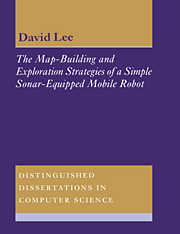 The Map-Building and Exploration Strategies of a Simple Sonar-Equipped Mobile Robot
The Map-Building and Exploration Strategies of a Simple Sonar-Equipped Mobile Robot Published online by Cambridge University Press: 05 March 2012
Published work shows a variety of approaches to exploration for mobile robots, ranging from disregarding the issue completely through to detailed mathematical analysis of exploration algorithms. This chapter reviews this work in the context of the recent debate between ‘reactive’ and ‘model-based’ robotics (as discussed in Section 2.1).
Many of the published papers on the map-building and navigation of mobile robots do not consider the question of exploration at all. This is, of course, often just a choice of research focus; effort is expended on the mechanics of map construction from sensor data without worrying about how the sensing positions were selected. On the other hand there are theoretical reasons why some researchers have chosen not to study exploration. A robot will not need to explore if its application is such that it does not need a map (Brooks 1990, pages 8–9) or if the map is to be supplied by the operator (Crowley 1985; Drumheller 1987). Neither of these arguments apply in the context of this thesis. Section 2.1 argued that a map was needed for the proposed delivery application and Section 3.4 explained the reasons for allowing ARNE to build its own maps.
Some researchers (Engelson (1992), for example) have adopted a strategy of ‘passive’ mapping, in which the map is built while the robot carries out its normal activities. In contrast, the current research proposes an initial exploration period during which the robot' objective is simply to learn about its environment.
To save this book to your Kindle, first ensure [email protected] is added to your Approved Personal Document E-mail List under your Personal Document Settings on the Manage Your Content and Devices page of your Amazon account. Then enter the ‘name’ part of your Kindle email address below. Find out more about saving to your Kindle.
Note you can select to save to either the @free.kindle.com or @kindle.com variations. ‘@free.kindle.com’ emails are free but can only be saved to your device when it is connected to wi-fi. ‘@kindle.com’ emails can be delivered even when you are not connected to wi-fi, but note that service fees apply.
Find out more about the Kindle Personal Document Service.
To save content items to your account, please confirm that you agree to abide by our usage policies. If this is the first time you use this feature, you will be asked to authorise Cambridge Core to connect with your account. Find out more about saving content to Dropbox.
To save content items to your account, please confirm that you agree to abide by our usage policies. If this is the first time you use this feature, you will be asked to authorise Cambridge Core to connect with your account. Find out more about saving content to Google Drive.